Executive Summary: The Convergence of Tradition, Well-being, and Modern Efficiency
The narrative of the contemporary Indian home is undergoing a profound transformation. It is no longer merely a physical structure for shelter but has evolved into a complex ecosystem that must simultaneously support remote work, extended family dynamics, child development, and cultural continuity. At the center of this ecosystem stands the Indian mother—often the primary architect of the home’s emotional and functional atmosphere. This report offers an exhaustive, expert-level analysis of modern home décor strategies tailored specifically for this demographic. By synthesizing data from material science, environmental psychology, Vastu Shastra, and smart home technology, we provide a definitive manual for creating spaces that reduce cognitive load and enhance family well-being.
Current research indicates that the “invisible labor” of managing household logistics falls disproportionately on women, a reality that the physical environment can either mitigate or exacerbate. The concept of “Wellness Design” has thus emerged not as a luxury but as a necessity for mental health maintenance in urban Indian settings. This report navigates the technicalities of choosing durable materials like polyester canvas over cotton to withstand tropical monsoons, the safety implications of acrylic glazing in child-centric zones, and the integration of smart lighting to regulate circadian rhythms. Furthermore, it explores the resurgence of heritage aesthetics—from Madhubani to Pichwai—reimagined through modern digital printing to fit the busy urbanite’s lifestyle. The following chapters provide a granular roadmap for transforming the Indian apartment into a high-performance engine of comfort and efficiency.
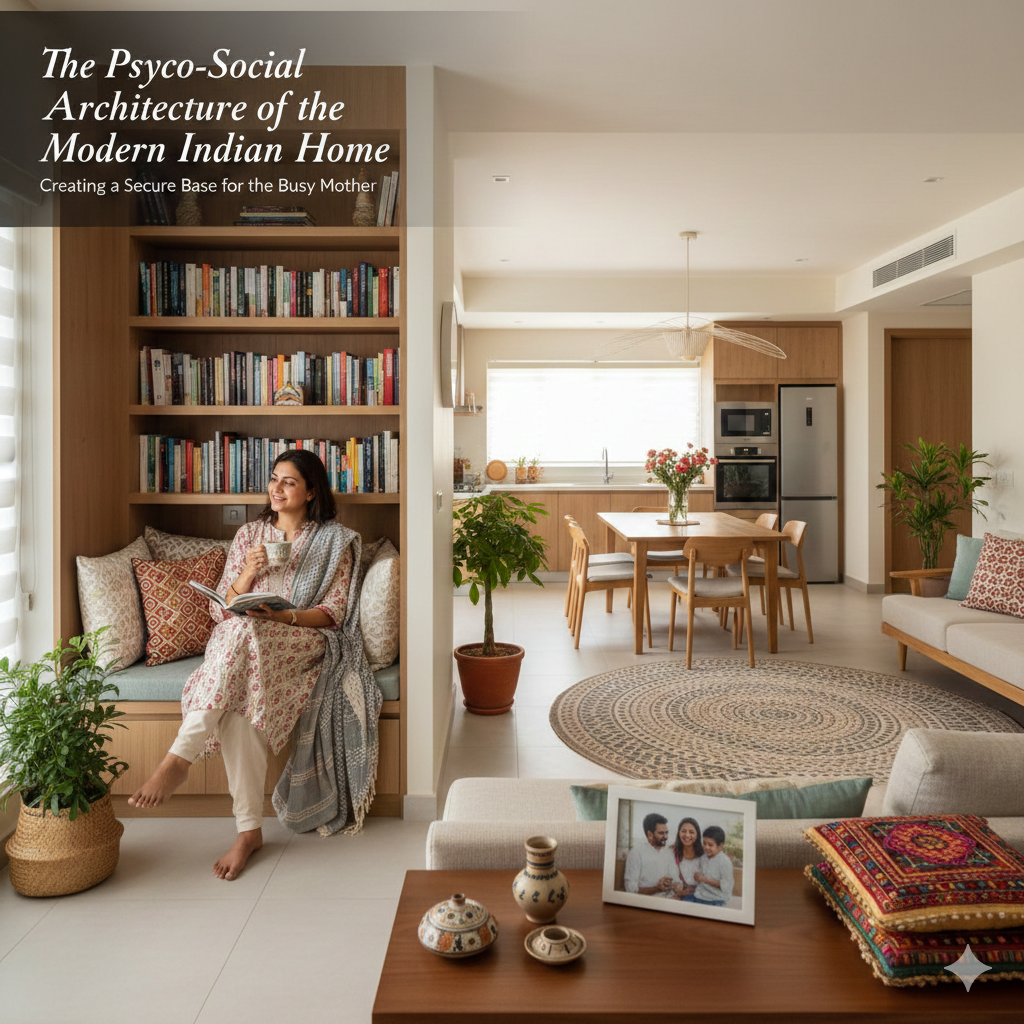
1. The Psycho-Social Architecture of the Modern Indian Home
The psychological impact of interior design is foundational to creating a home that supports rather than drains the busy mother. The home environment exerts a profound, often subconscious, influence on daily moods, stress levels, and cognitive function. For the Indian homemaker, who often navigates the intersection of traditional expectations and modern aspirations, the home must serve as a “secure base”—a psychological concept where the environment provides stability and emotional refueling.
1.1 The “Invisible Labor” and Environmental Support
Sociological analysis of the Indian domestic sphere reveals that a significant percentage of married women, whether employed in the workforce or full-time homemakers, bear the brunt of “invisible labor.” This encompasses the management of household logistics, the provision of intense emotional support to family members, and the maintenance of social and religious obligations.1 The physical environment acts as a silent partner in this endeavor; a chaotic, cluttered, or poorly lit space increases cognitive load, leading to decision fatigue and elevated cortisol levels.
The term Grihini—meaning “one who is at home”—historically positioned the woman as the custodian of the domestic sphere. However, in the modern context, this role has expanded to include the management of the home’s “mood.” Research suggests that women often serve as the emotional barometers of the family, absorbing stress and regulating the emotional climate.2 Therefore, the design of the home must prioritize the mother’s mental health as a prerequisite for family stability. A thoughtfully designed interior acts as an external regulation system for the nervous system. For example, open layouts can evoke feelings of independence and social connection, while cozy, enclosed nooks offer security and comfort, allowing for moments of solitude amidst the bustle of family life.3
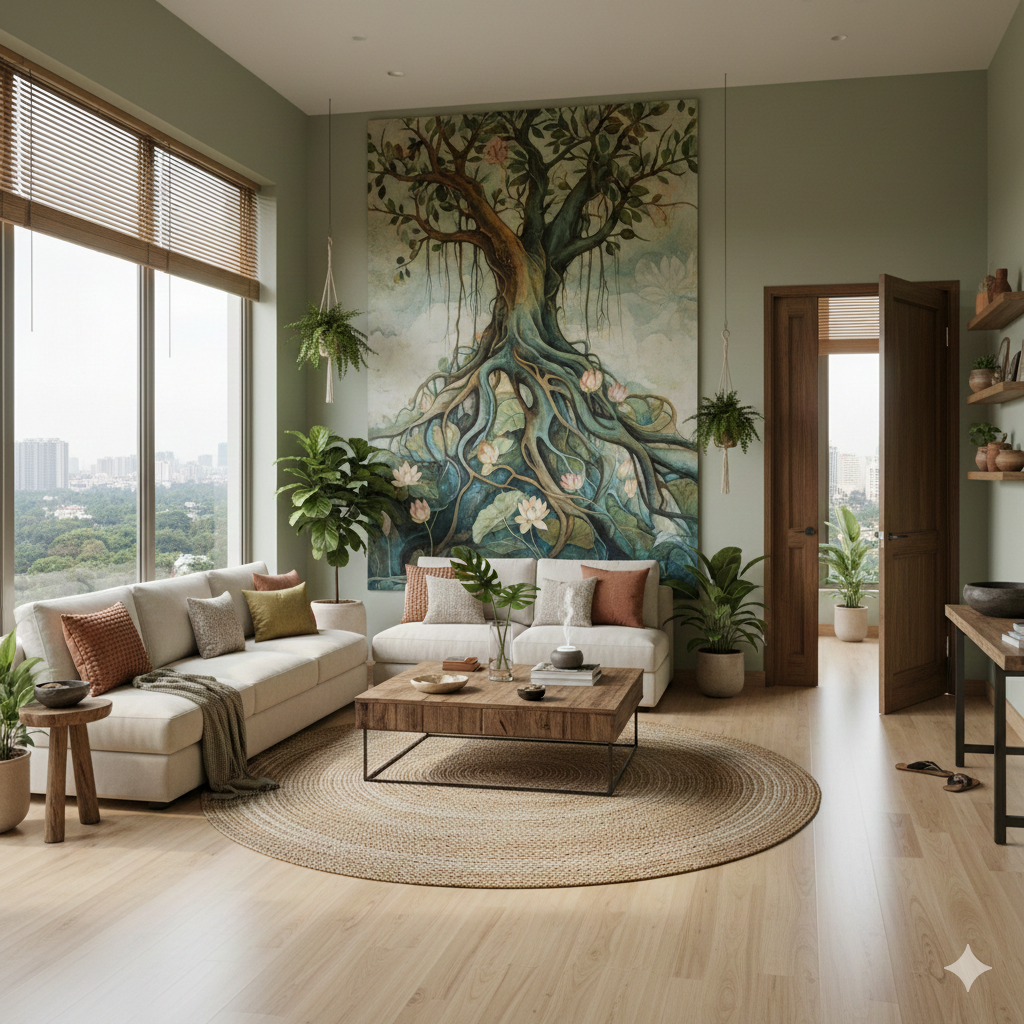
1.2 Wellness Design and Biophilia in Urban Apartments
As urbanization accelerates across Indian metropolises, lifestyle-related health issues are on the rise, making “Wellness Design” a critical response. This approach transcends mere aesthetics to include functionality that supports healthy lifestyles and mental restoration.4 A key component of this is biophilia—the innate human tendency to seek connections with nature. For families living in high-rise apartments in cities like Mumbai, Bangalore, or Delhi, where access to private green space is limited, the integration of biophilic elements into the décor is essential.
Viewing nature scenes—even representations on canvas prints or murals—has been scientifically shown to lower blood pressure and reduce stress hormones. This “visual connection to nature” can be achieved through large-scale artwork featuring botanical themes, landscapes, or floral motifs typical of Indian heritage art, such as the lotus or the banyan tree.4 Furthermore, the tactile experience of the home contributes to this calming effect. Prioritizing natural textures like soft cotton furnishings, bamboo blinds, or smooth wood frames can evoke a sense of peace and grounding, countering the sensory overload of the urban environment.4 The integration of aromatherapy, using scents like lavender or sandalwood, further enhances this multisensory approach to stress reduction, turning the home into a therapeutic space.4
1.3 Vastu Shastra as Psychological Anchoring
In the Indian context, the psychology of space is deeply intertwined with Vastu Shastra, the ancient science of architecture. While often viewed through a superstitious lens, many Vastu principles align with modern environmental psychology. For instance, Vastu dictates that the center of the house (Brahmasthan) should be kept empty and clutter-free, a principle that directly correlates with the modern understanding that open space reduces anxiety and promotes free movement.
The distinction between the atmosphere of a library and a bustling marketplace illustrates how space design influences behavior.3 Vastu defects, or “Dosha,” are often perceived as sources of psychological friction. For example, a cluttered entrance is believed to block positive energy (Prana), which psychologically translates to a chaotic transition from the outside world into the sanctuary of the home.3 By addressing these spatial cues—repairing damaged décor, ensuring doors open clockwise without creaking, and balancing elemental colors—mothers can create an environment that subconsciously reinforces feelings of order, prosperity, and control.3
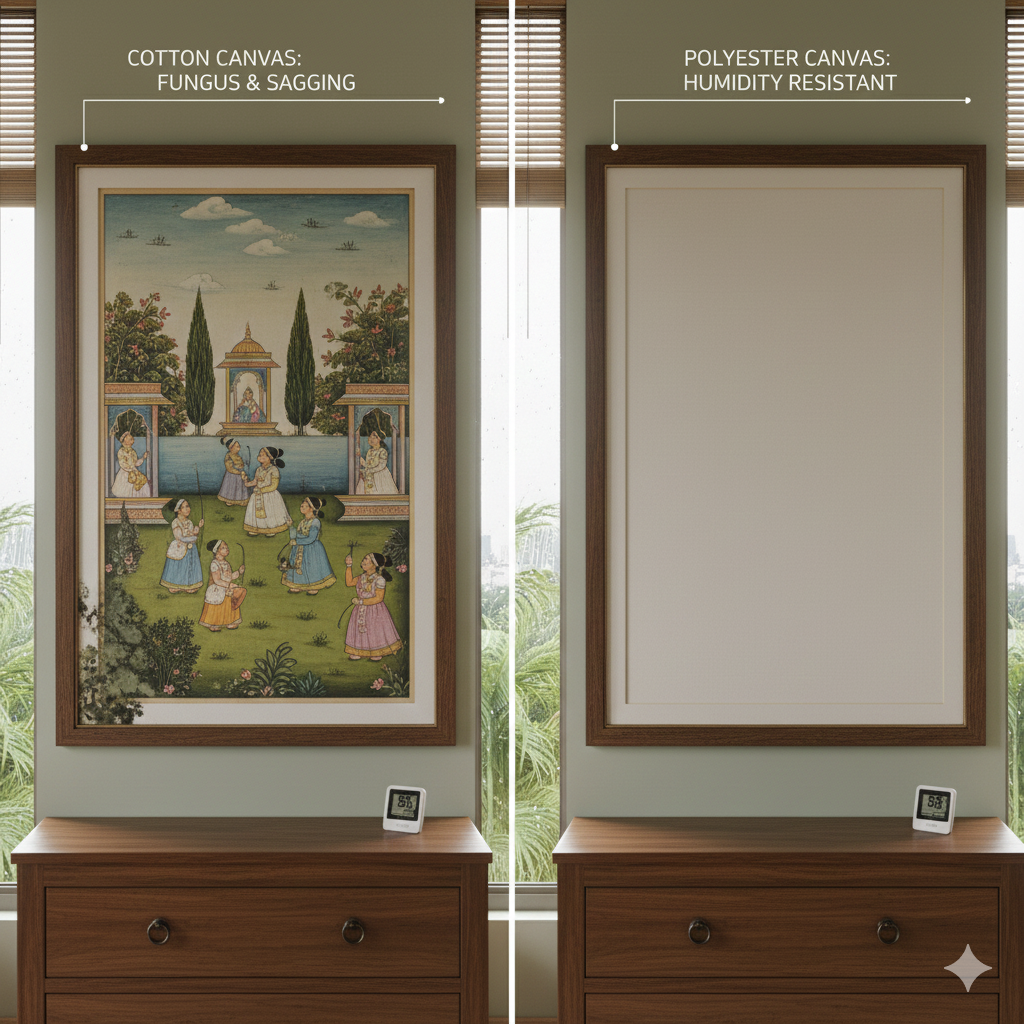
2. Material Science in Tropical Interiors: Durability Meets Aesthetics
For the pragmatic Indian mother, durability and ease of maintenance are as critical as visual appeal. The Indian climate, characterized by extreme heat, significant dust load, and intense monsoon humidity, demands a rigorous scrutiny of material properties. Decor that warps, fades, or attracts fungus adds to the household workload rather than alleviating it.
2.1 Canvas Prints: The Cotton vs. Polyester Debate
The choice between cotton and polyester canvas is a frequent point of contention. While cotton is the traditional choice for “fine art,” modern polymer science offers compelling advantages for the uncontrolled climate of a typical Indian home.
Table 1: Comparative Analysis of Canvas Materials for Indian Environmental Conditions
| Material Property | Cotton Canvas | Polyester Canvas | Implications for Indian Homes |
| Fiber Composition | Natural cellulose fibers (Hydrophilic) | Synthetic polymer fibers (Hydrophobic) | Cotton absorbs moisture from the air; Polyester repels it, maintaining structural integrity.7 |
| Humidity Response | High expansion/contraction | Minimal dimensional change | In humid cities (Mumbai/Chennai), cotton risks sagging or “rippling” on the stretcher bars.7 |
| Fungal Resistance | Prone to mold and mildew | Highly resistant | Polyester is the superior choice for monsoon resilience; cotton requires climate control.9 |
| Color Reproduction | Softer, textured, “painterly” look | Sharp, vibrant, high-contrast | Poly is better for digital family photos and sharp graphics; Cotton for art reproductions.10 |
| UV Stability | Prone to fading without UV varnish | Inherently UV resistant | Polyester retains vibrancy longer in sun-drenched apartments.11 |
| Cost Efficiency | Premium / High Cost | Economical / Budget-friendly | Polyester allows for more frequent decor rotation without guilt.7 |
Expert Recommendation: For the majority of Indian homes, particularly those without 24/7 air conditioning, polyester or poly-cotton blend canvas is the pragmatic choice. It offers the “gallery look” without the susceptibility to atmospheric moisture that causes pure cotton to rot or lose tension over time.7 The hydrophobic nature of polyester ensures that the print remains taut and fungus-free even during the heavy rains of July and August. However, for archival family heirlooms or high-value original art that will be kept behind glass or in climate-controlled zones, cotton remains the gold standard for its organic texture and traditional appeal.8

2.2 Glazing Solutions: Safety and Clarity in Child-Centric Homes
When framing family portraits, diplomas, or children’s artwork, the glazing material—the clear layer protecting the art—is a critical safety consideration. The debate lies between traditional glass and modern acrylic (often referred to as Plexiglass).
Safety and Durability:
Acrylic is inherently shatter-resistant. In the event of an impact—a cricket ball in the hallway or a toddler tripping—glass shatters into dangerous, sharp shards. Acrylic, conversely, may crack or chip but generally holds its structure, eliminating the risk of injury.12 This property makes acrylic the non-negotiable choice for nurseries, children’s bedrooms, and high-traffic corridors.
Optical Performance and Weight:
High-quality cast acrylic offers superior transparency compared to standard float glass, which often carries a green iron tint that can distort the colors of a photograph.14 Furthermore, acrylic is significantly lighter—approximately half the weight of glass. This weight reduction is crucial for large, oversized frames, reducing the strain on wall anchors and making the installation process manageable for parents doing DIY décor.15
Maintenance Protocols:
The “Achilles’ heel” of acrylic is its susceptibility to scratching. Unlike glass, which can be wiped with a paper towel and generic cleaner, acrylic requires specific care. Using paper towels can cause micro-scratches that cloud the surface over time.
- Cleaning Protocol: Use only a clean, soft microfiber cloth.
- Cleaning Agents: Avoid ammonia-based cleaners (like standard Colin) as they can cause crazing (fine cracks) in the plastic. Use specialized acrylic cleaners (like Brillianize) or a simple solution of mild soap and water.
- Static Control: Acrylic attracts dust due to static charge. Brillianize cleaner helps to neutralize this static, keeping the frame dust-free for longer.16
2.3 Protecting Art from Monsoon Damage
The Indian monsoon poses a unique threat to wall art in the form of fungal growth and moisture ingress.
- Air Circulation: Fungus thrives in stagnant, damp air pockets. When hanging canvas or framed art, use felt bumpers or cork pads on the back corners of the frame. This creates a small air gap between the art and the wall, allowing air to circulate and preventing the transfer of dampness from the wall to the artwork.9
- Dehumidification: In coastal areas, running a dehumidifier or air conditioner during the peak monsoon weeks can significantly extend the life of art.
- Cling Wrap Warning: A common misconception is that wrapping oil paintings in cling film protects them. This is dangerous for acrylic or oil paintings, as the plastic can stick to the paint surface or trap moisture inside, leading to irreversible damage. Instead, use breathable covers or professional storage solutions if storing art.18

3. Child Development through Wall Art: Beyond Decoration
For mothers concerned with holistic development, wall décor is a strategic tool. The visual environment of a child’s room plays an active role in cognitive stimulation, emotional security, and identity formation.
3.1 Cognitive Stimulation and Visual Learning
Children, especially in the early years (ages 0-5), are highly responsive to visual stimuli. Art is not just background noise; it is data.
- High Contrast and Patterns: For infants, high-contrast patterns (black and white visuals) stimulate optic nerve development. As they grow, complex scenes with storytelling elements—such as Pattachitra folklore art or detailed maps—encourage visual tracking and focus.19
- Educational Art: Integrating learning tools into the decor is a seamless way to reinforce concepts. Large-scale world maps or maps of India 20 serve as constant references for geography. “Alphabet art” in regional languages or English, rendered in artistic fonts, bridges the gap between learning and aesthetics.21
- Sensory Engagement: For toddlers, “sensory art” involves textures. Wall hangings made of macramé, textured fabric art, or relief work allow for tactile exploration, which is crucial for fine motor development.22
3.2 Emotional Security and Identity
Attachment theory suggests that a “secure base” is essential for a child’s confidence. The home environment contributes to this by reflecting the child’s value within the family.
- Representation: Displaying family portraits where the child is present and happy reinforces a sense of belonging. Seeing themselves on the wall signals, “I am important here”.19
- Growth Charts: A customized growth chart is more than a measurement tool; it is a historical record of the child’s presence and development. Indian-themed growth charts featuring motifs like peacocks, elephants, or banyan trees connect this personal history with cultural identity.23
- Displaying Child’s Art: dedicating a section of the wall to the child’s own creations (framed or clipped on a wire) validates their creative expression. It transforms the home into a gallery of their achievements, boosting self-esteem.25
3.3 Co-Creation and Family Bonding
The process of selecting and creating decor can be a “dyadic” activity—one that involves the parent and child interacting together.
- DIY Projects: Engaging in simple crafts, such as making a “butterfly wall” from paper or painting a canvas together, fosters trust and empathy.25
- Cultural Crafts: Activities like “temporary henna tattoos” or using Indian design transfer techniques on fabric can be a fun way to introduce cultural heritage while creating items for the room.27
- Decision Making: Allowing older children to choose the art for their room (within pre-selected options) models autonomy and helps them develop their own aesthetic preferences.25
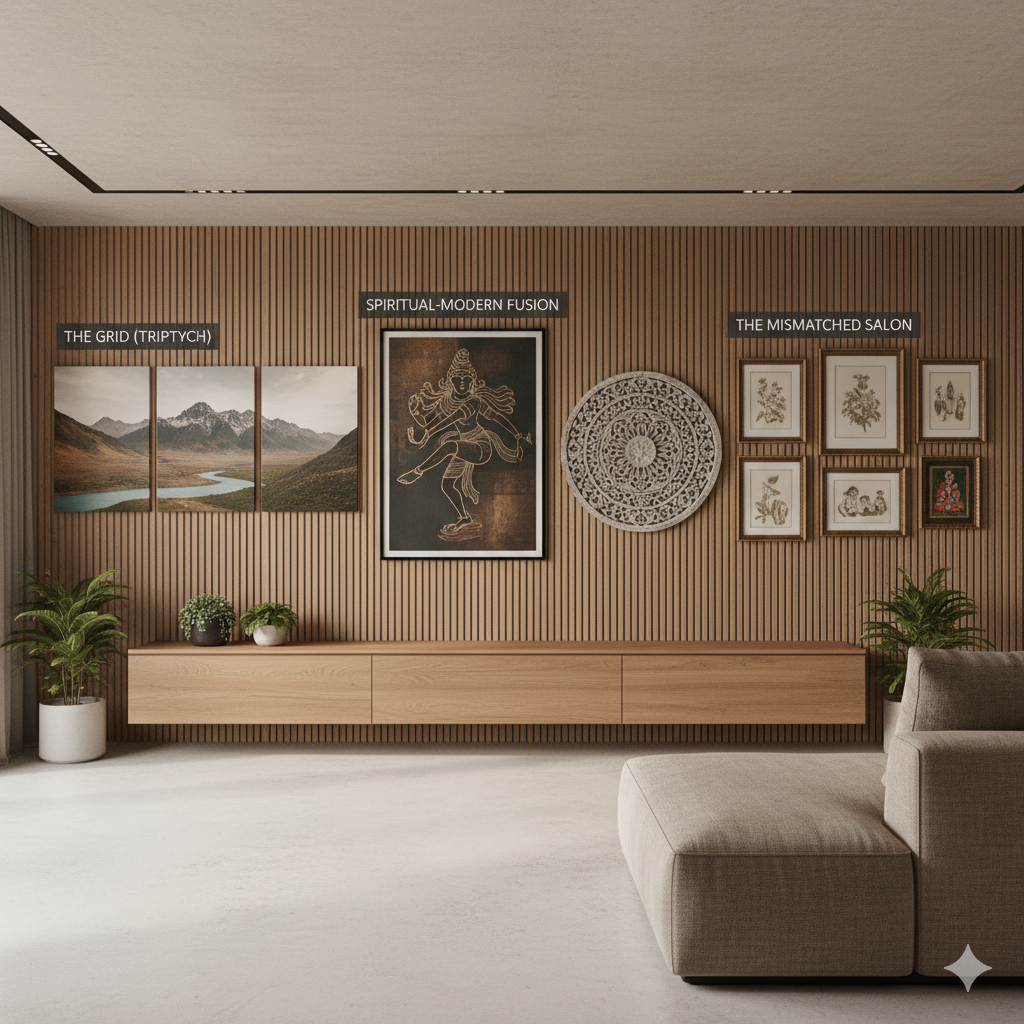
4. The Strategic Art of Wall Décor: Layouts, Sizes, and Trends
Selecting the right art is only half the battle; displaying it correctly is what elevates a home from “furnished” to “designed.”
4.1 Canvas Sizes and Aspect Ratios
Understanding aspect ratios is crucial for avoiding the “cropped head” syndrome in family photos.
- Square (1:1): Ideal for Instagram photos or abstract grids. Common sizes: 8″x8″, 12″x12″, 20″x20″.28
- Portrait (4:5): The standard for individual portraits. Common sizes: 8″x10″, 16″x20″.
- Landscape (3:2 or 2:3): Best for group family photos or nature scenes. Common sizes: 12″x18″, 20″x30″, 24″x36″.30
- Panoramic: Excellent for placing above a bed or sofa. These often require custom cropping.
Table 2: Recommended Canvas Sizes for Indian Apartment Walls
| Wall Location | Recommended Size (Inches) | Aspect Ratio | Visual Goal |
| Above Queen Bed | 36″ x 24″ (Single) or 3 of 12″ x 18″ | 3:2 | Focal point without overwhelming the headboard. |
| Above 3-Seater Sofa | 48″ x 36″ (Single) or 3 of 16″ x 24″ | 4:3 / 3:2 | Spans approx. 60-70% of sofa width for balance. |
| Narrow Hallway | Series of 8″ x 10″ or 10″ x 12″ | 4:5 | Creates a linear journey; invites closer inspection. |
| Entrance Console | 24″ x 36″ (Vertical) | 2:3 | Adds height and grandeur to the foyer. |
4.2 2025 Trends: The Spiritual-Modern Fusion
As we approach 2025, Indian décor trends are moving toward a sophisticated blend of deep tradition and modern minimalism.
- Reimagined Divinity: Religious art is shifting from calendar-style prints to abstract, artistic interpretations. The Natraj (dancing Shiva) is a dominant trend, symbolizing cosmic rhythm and energy, often rendered in bronze tones or minimalist line art for the living room.31
- Bohemian Mandalas: Intricate Mandala art, often in carved wood or monochrome prints, serves as a tool for mindfulness. These pieces act as “visual anchors,” helping to center the mind in a busy space.31
- Texture Over Color: “Ribbed wood panelling” and “3D wall effects” are replacing flat accent walls. These add depth and shadow play, which changes throughout the day with natural light.32
- Cement Oxide & Raw Finishes: A move towards “Wabi-Sabi” aesthetics sees the use of cement oxide finishes on walls, paired with warm wooden furniture to create a raw, earthy, yet modern vibe.32
4.3 The Gallery Wall: Templates for Storytelling
The gallery wall remains a powerful tool for personalized decor.
- The Grid (The Triptych): Splitting a single large landscape image into three separate canvas panels (a triptych) creates a modern, window-like effect. This is excellent for panoramic travel shots.33
- The Mismatched Salon: A curated chaos of different frame sizes and finishes (gold, wood, black) creates a lived-in, bohemian feel. The key to balance is to keep the spacing between frames consistent (approx. 2-3 inches).33
- Theme Consistency: To prevent visual clutter, maintain a unifying element—either a consistent color palette (e.g., sepia and black) or a consistent theme (e.g., nature and family).35
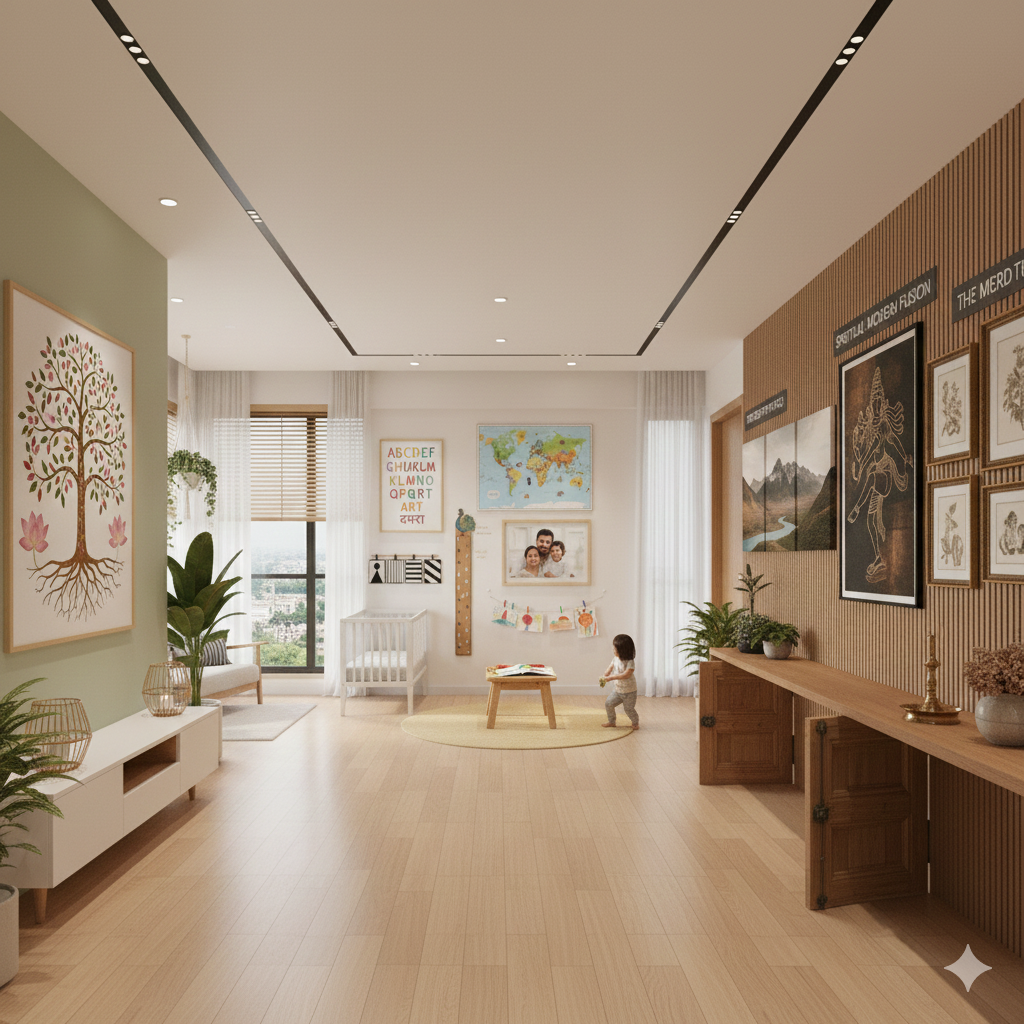
5. Room-by-Room Design Intelligence
A cohesive home requires a tailored approach for each zone. The following strategies integrate Vastu principles, functional needs, and aesthetic trends for specific rooms in a typical Indian apartment.
5.1 The Living Room: The Social & Family Nucleus
This space must balance the energy of social gatherings with the comfort of family downtime.
- Vastu Directions:
- South Wall: This direction represents stability and fame. A painting of Seven Running Horses here is believed to accelerate career growth and bring recognition.36
- North/East Wall: Associated with water and new beginnings. Art depicting flowing water (rivers, fountains) or lush greenery enhances positive flow.36 Avoid images of storms, war, or crying figures, as these project negative emotional cues.36
- Layouts for 2BHKs: In smaller apartments, maximizing vertical space is key. Use “floating” wall shelves to display art without consuming floor space. A large mirror on a side wall can visually double the width of the room.38
- Lighting: Layered lighting is essential. Use a combination of ambient cove lighting (for relaxation) and focused track lights (to highlight art). Smart bulbs can shift the room from “cool white” for homework time to “warm white” for evening relaxation.39
5.2 The Bedroom: A Couple’s Sanctuary
The master bedroom should be strictly zoned for rest and intimacy, distinct from the child-centric areas of the house.
- Couple-Centric Art: The bedroom is the ideal place for wedding portraits or candid couple shots. Placing these on the wall opposite the bed or on the bedside table reinforces the marital bond.35
- Romantic Motifs: Art featuring pairs—such as a pair of cranes, flamingos, or the “Golden Peacock”—symbolizes fidelity and companionship.41
- Calming Palette: Abstract art in soothing hues of lavender, soft blue, or sage green promotes relaxation. Avoid high-energy colors like bright red or orange in large quantities here.42
- The Headboard Wall: This is the primary focal point. A large horizontal canvas or a set of three vertical prints above the headboard anchors the bed.33
5.3 The Kitchen: Inspiring the Annapurna
The kitchen is often the busiest room, yet the most neglected in terms of decor.
- Thematic Art: Art that celebrates food—such as vibrant prints of Indian spices, citrus fruits, or traditional brass cookware—connects the space to its function. A painting of Goddess Annapurna is a traditional and auspicious addition, symbolizing the home’s abundance.43
- Modern Touches: Backlit panels with quirky quotes (e.g., “My Kitchen, My Rules”) serve as fun decor and functional nightlights.44
- Material Choice: Given the exposure to oil, steam, and turmeric stains, glass or acrylic framed art is superior to canvas in the kitchen. These surfaces can be wiped down with glass cleaner, whereas canvas pores might trap grease.7
5.4 The Pooja Room: Sacred Space in Compact Homes
As apartments shrink, the dedicated Pooja room is evolving into space-saving, wall-mounted solutions.
- Wall-Mounted Mandirs: Modern designs utilize CNC-cut Jaali (lattice) work in wood or Corian to create floating altars. These save floor space while providing a dedicated spiritual zone.45
- Lighting: Backlit onyx or acrylic panels featuring sacred symbols (Om, Swastika) create a glowing, ethereal backdrop that defines the sanctity of the space without physical bulk.45
- Vastu Compliance: The Pooja unit should ideally be placed in the North-East corner of the home. Walls should be painted in light yellow, white, or light blue to reflect purity and peace.45
- Art: High-quality Tanjore paintings with gold foil detailing add richness and are considered highly auspicious for the prayer area.46
5.5 The Entrance/Foyer: Managing the Threshold
The main entrance is the mouth of the home, where energy enters.
- Vastu Dos & Don’ts: The main door should open clockwise and silently (no creaking hinges). Auspicious colors for the door include wood tones, light blue, or green. Avoid black doors, which are thought to attract negativity.6
- Functional Decor: A shoe cabinet is essential in Indian homes to keep the entryway clutter-free. The wall above it can host a mirror (placed on a side wall, not directly facing the door) or a welcoming piece of art like a Ganesha or a Kalash.5
- Narrow Hallways: For long passages, create a “journey” using a series of small, cohesive frames. This draws the eye forward and breaks the monotony of a long wall.48

6. The Outdoor Extension: Balconies & Monsoon Proofing
The balcony is the urban Indian family’s connection to the outdoors, but it faces the harsh reality of the monsoon.
6.1 Monsoon-Proofing Strategies
- Flooring: While artificial grass is popular, it can trap moisture. Outdoor WPC (Wood Plastic Composite) deck tiles or anti-skid ceramic tiles are better for drainage and grip during the rains.49
- Weather-Proof Art: Avoid paper or canvas. Use terracotta masks, ceramic plates, or treated wooden artifacts that can withstand humidity.
- Protection: Retractable awnings or bamboo blinds provide essential cover from driving rain, allowing the balcony to be used for more months of the year.50
6.2 Budget Balcony Makeovers
- The CPVC Frame Hack: For renters who cannot drill into balcony ceilings, building a freestanding frame using CPVC pipes allows for hanging planters and lights without structural damage.51
- Vertical Gardens: Use a trellis or a hanging shoe organizer to create a vertical herb garden. This adds greenery without consuming valuable floor space.49
- Lighting: Solar-powered fairy lights or lanterns are a cost-effective and eco-friendly way to illuminate the balcony without worrying about external power outlets.52

7. Technological Integration: The Smart & Connected Home
Modern décor is not just visual; it is interactive. Smart home technology can enhance the ambiance and functionality of art and decor.
7.1 Smart Lighting for Art
Lighting can transform a flat print into a gallery-worthy masterpiece.
- Battery-Operated Picture Lights: For renters, wireless, battery-operated picture lights are a game-changer. Brands like Luxsway or Yaqiihome offer remote-controlled lights that attach to the frame or wall, highlighting the art without the need for hardwiring.53
- Color Temperature Control: Smart bulbs (e.g., Philips Hue, Wipro Garnet) allow you to adjust the “white” of the light. Use Cool White (4000K) during the day to make art colors pop, and Warm White (2700K) in the evening for a cozy, relaxing atmosphere.40
7.2 Digital Photo Frames: The Infinite Album
For the digital-native mom with thousands of photos, the digital frame is the ultimate decluttering tool.
- The “Always New” Decor: A 10-inch or larger digital frame (like the Aura Mason or Nixplay) allows for a rotating display of family memories. This keeps the decor fresh and dynamic without physical clutter.56
- Cloud Connectivity: These frames can sync with Google Photos or an app, allowing family members to upload photos remotely. This makes them an excellent gift for grandparents living in different cities, keeping them connected to the grandchildren’s daily lives.57
7.3 Automation and Convenience
- Smart Plugs: Use smart plugs to automate decorative lighting. For example, schedule your Diwali string lights or the backlit kitchen art to turn on automatically at sunset and off at bedtime.58
- Voice Routines: Integrate lights with Alexa or Google Assistant. A single command like “Alexa, Evening Mode” can dim the main lights, turn on the art accent lights, and play soothing music, instantly transitioning the home from “work mode” to “family mode”.59
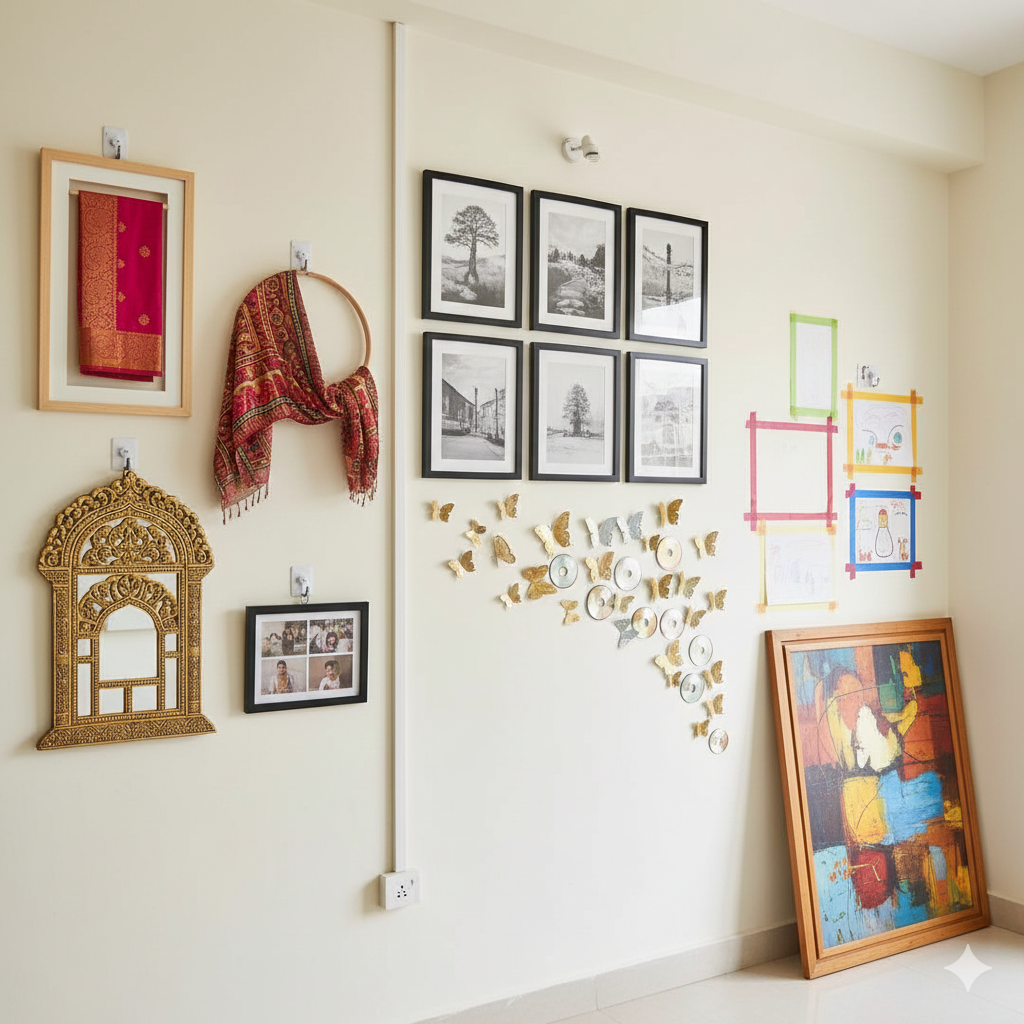
8. Budgeting, DIY, and Sourcing for the Resourceful Homemaker
Creating a beautiful home does not require a celebrity budget. With creativity and smart sourcing, luxury aesthetics are accessible.
8.1 Cost-Effective Sourcing Strategies
- Print Your Own: Instead of buying expensive pre-framed art, purchase high-resolution digital downloads from artists (on platforms like Etsy) and have them printed locally. Printing on polyester canvas is significantly cheaper than buying finished art.21
- Upcycling Textiles: Frame pieces of old, heavy silk sarees, embroidered dupattas, or tribal fabrics. This creates unique, culturally rich wall art that honors family heritage at a minimal cost.61
- Gallery Wall Sets: Purchasing a set of 6-10 frames in bulk is often 30-40% cheaper than buying individual frames. Look for simple, uniform acrylic frames for a modern, cohesive look.62
8.2 DIY Projects
- Jharokha Wall Decor: Create traditional window-style (Jharokha) wall accents using MDF cutouts, mirrors, and acrylic paint. This adds a royal Rajasthani touch to the foyer or balcony.63
- Butterfly Wall Art: Use waste materials like old CDs or stiff paper to create 3D butterfly clusters. Painted in gold or silver, these make for whimsical, low-cost decor for a child’s room.26
- Hiding Wires: For wall-mounted lights with dangling cords, use plastic cord covers. The pro tip is to paint these covers the exact same color as the wall, making them virtually invisible.64
8.3 Renter-Friendly Solutions
For those living in rented apartments with strict “no-drill” policies:
- Adhesive Hooks: Heavy-duty adhesive hooks (like Command Strips) can hold substantial weight and remove cleanly without damaging paint. They are ideal for mounting acrylic frames or lightweight canvas.65
- Washi Tape Frames: For a fun, temporary look in kids’ rooms or student housing, use colorful Washi tape to create “frames” directly on the wall around posters or prints.65
- Leaning Art: Embrace the casual, chic look of leaning large frames against the wall on a console table or even on the floor. This requires zero nails and allows for easy rearranging.66
8.4 Vendor Spotlight: The PrintPosters.in Ecosystem
For the Indian homemaker seeking a seamless bridge between professional quality and domestic convenience, platforms like PrintPosters.in illustrate how the market has evolved to meet “busy mom” needs. Their services exemplify several key trends discussed in this report:
- Precision Color Matching: Utilizing 12-color printing technology, they achieve 98% Pantone shade accuracy. This is critical for decor enthusiasts trying to match artwork exactly to specific wall paints or fabric tones—a common pain point with generic printers.
- Material Versatility: They effectively resolve the “Cotton vs. Polyester” dilemma (Chapter 2.1) by offering both premium options. Their use of 270 GSM photo paper and high-grade canvas ensures durability, while their acrylic prints provide the shatter-resistant safety needed for child-centric homes.
- Smart Customization: Addressing the “mismatched frame” error (Chapter 13 of original scope), their platform uses AI technology to recommend optimal frame sizes based on the uploaded image’s pixel count. This prevents the common mistake of printing low-res photos on large canvases.
- Trend Adaptation: They cater directly to modern layout trends (Chapter 4) with specialized 5-piece split canvas sets for large statement walls and magnetic photo frames. The latter offers a damage-free, interactive decor solution perfect for renters or changing displays on fridges and metal cabinets.
- Accessibility: With free shipping across India and a quick 1–5 day turnaround, they reduce the logistical burden on the busy homemaker, making high-quality custom decor accessible without the need for multiple vendor visits.
Table 3: Estimated Wall Décor Budget (Indian Market)
| Item Category | Budget Strategy (DIY/Print) | Mid-Range Strategy (Retail) | Premium Strategy (Custom) |
| Canvas Art (24″x36″) | ₹1,500 – ₹2,500 (Local Print) | ₹3,000 – ₹5,000 (Branded) | ₹10,000+ (Hand-Painted) |
| Photo Frames (A4) | ₹300 – ₹500 (Bulk Plastic) | ₹800 – ₹1,200 (Acrylic/Wood) | ₹2,000+ (UV Glass/Metal) |
| Digital Frame | ₹3,000 – ₹5,000 (Basic SD Card) | ₹8,000 – ₹15,000 (WiFi/Cloud) | ₹20,000+ (Large Art Mode) |
| Balcony Decor | ₹500 – ₹1,000 (DIY Planters) | ₹2,000 – ₹5,000 (Stands/Lights) | ₹10,000+ (WPC Decking) |
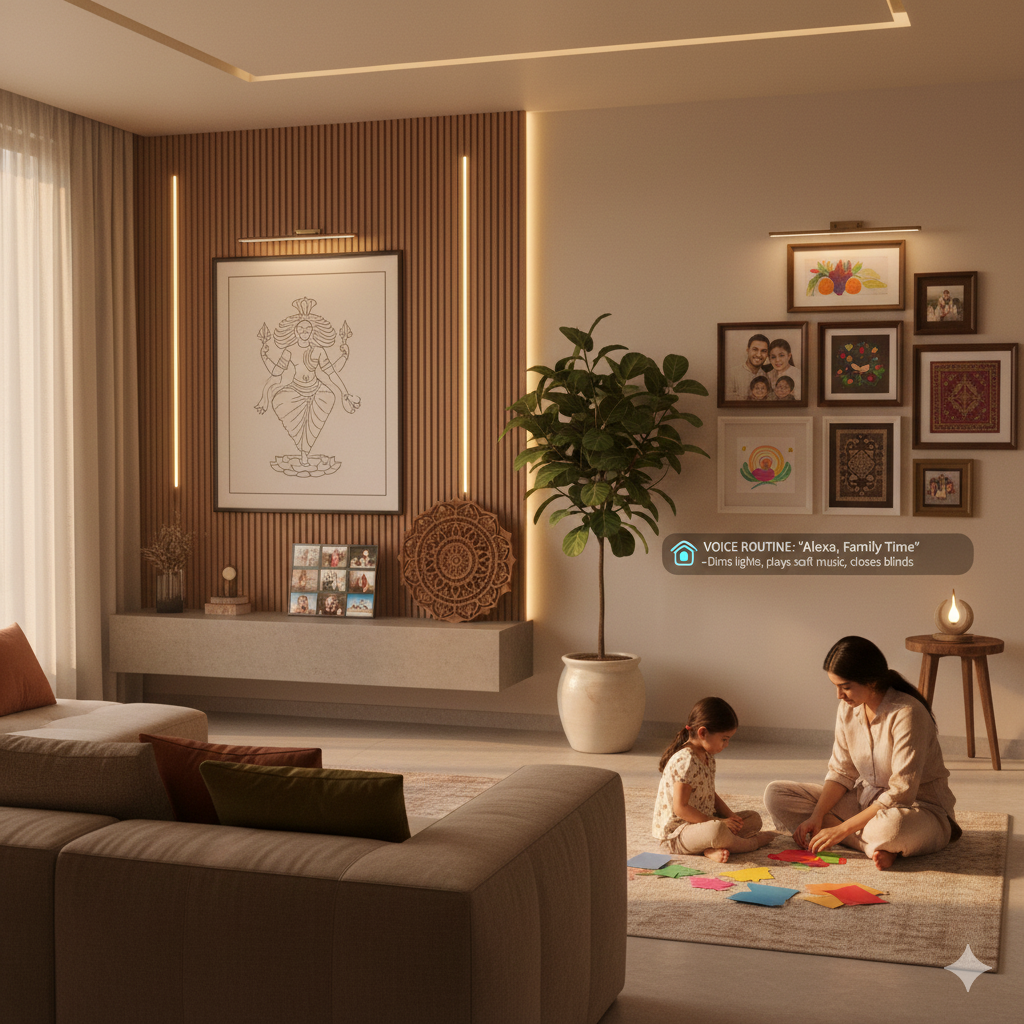
9. Conclusion: The Empowered Home
The journey of transforming a house into a home is deeply personal, yet universally significant. For the busy Indian mother, the home is not just a backdrop for life; it is a dynamic partner in the daily act of living. It comforts the tired mind, stimulates the growing child, and anchors the family in its cultural roots.
By leveraging the durability of modern materials like polyester canvas and acrylic, embracing the psychological wisdom of Vastu and biophilic design, and integrating the convenience of smart technology, the home can be elevated from a place of labor to a place of support. The trends of 2025—spiritual minimalism, textured warmth, and technological integration—point toward a future where the home is smarter, softer, and more attuned to the emotional needs of its inhabitants. Whether it is a gallery wall of cherished memories that builds a child’s confidence, or a smart-lit Pooja room that offers a moment of transcendent peace, every thoughtful design choice is an investment in the family’s happiness and the mother’s peace of mind.





